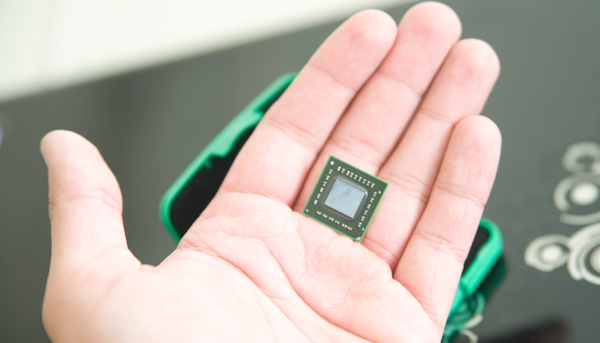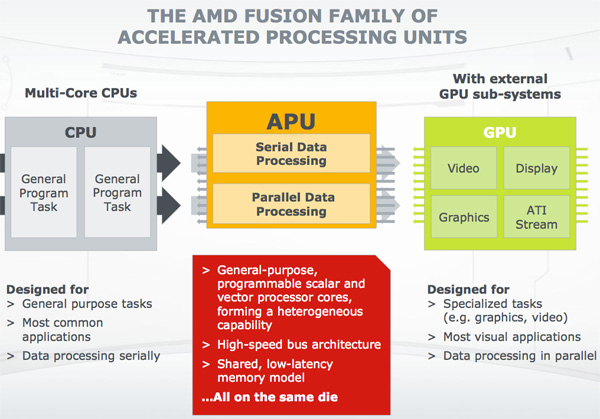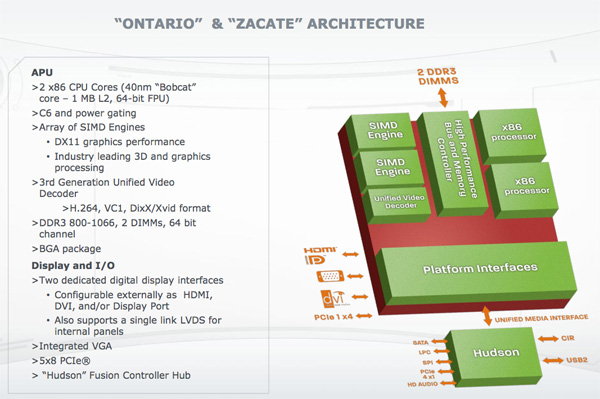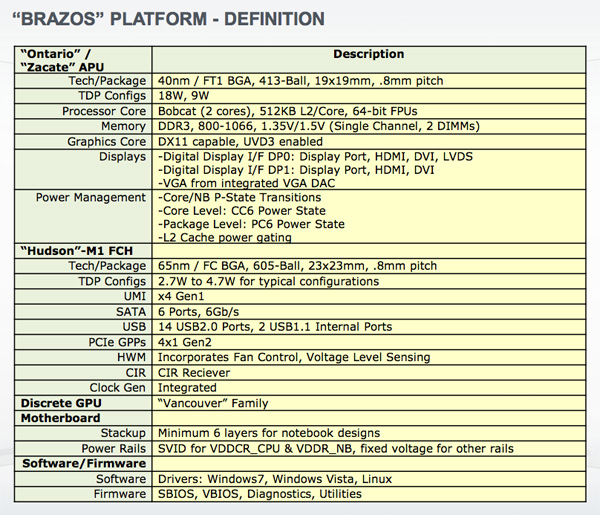Previewing AMD's Brazos, Part 1: More Details on Zacate/Ontario and Fusion
by Anand Lal Shimpi on November 9, 2010 1:09 AM ESTMeet the Brazos
The platform is called Brazos. Brazos encompasses two chips: a Zacate or Ontario APU (Accelerated Processing Unit) and the Hudson Fusion Controller Hub (FCH). This is the whole reason AMD bought ATI, Zacate and Ontario are its first CPU-GPU hybrids.
While AMD is primarily targeting the netbook/ultraportable and notebook markets with Ontario and Zacate (respectively), we’ll also see nettops/desktops and mini-ITX motherboards based on Brazos. This may be the first time we see real competition to NVIDIA’s ION platform.

AMD's Zacate APU, 19mm x 19mm package, 413 balls, 75mm^2 die
Both APUs are built from the same die. Zacate and Ontario are physically identical, they just run at different clock speeds. The 40nm die is manufactured at TSMC and measures 75mm^2. The chip is very cheap to package as well. The BGA package only has 413 balls. As one AMDer put it, these chips are designed to be stamped out as quickly and as cheaply as possible.
Both are available in single and dual core versions, although the single core variant is just a dual-core chip with one core disabled to hit various market segments. Core unlocking is apparently possible, but unexpected given the target for these platforms and the amount of effort OEMs would have to go to in order to enable it.
The CPU cores are based on AMD’s first truly low power client architecture, codenamed Bobcat. We’ve discussed Bobcat in great length already, but at a high level it looks a lot like an out-of-order Atom processor without Hyper Threading. The fundamental architecture advantage should give Bobcat the performance advantage over Atom, at least at identical clock speeds.
The GPU is based on AMD’s 5000 series architecture (Evergreen) and features 80 shader cores and AMD’s new UVD3 decode engine.
The SKUs
At launch you’ll see four SKUs, the combinations and specs are listed below:
| AMD Brazos Lineup | ||||||||
| APU Model | Number of Bobcat Cores | CPU Clock Speed | GPU | Number of GPU Cores | GPU Clock Speed | TDP | ||
| AMD E-350 | 2 | 1.6GHz | Radeon HD 6310 | 80 | 500MHz | 18W | ||
| AMD E-240 | 1 | 1.5GHz | Radeon HD 6310 | 80 | 500MHz | 18W | ||
| AMD C-50 | 2 | 1.0GHz | Radeon HD 6250 | 80 | 280MHz | 9W | ||
| AMD C-30 | 1 | 1.2GHz | Radeon HD 6250 | 80 | 280MHz | 9W | ||
Zacate takes the top two SKUs, while Ontario makes up the bottom two. The difference in TDP is entirely based on the clock speed of the CPU and GPU. And here is my concern. While a pair of Bobcats running at 1.6GHz are just awesome, drop the clock to 1.0GHz and I start getting concerned about performance. AMD didn’t let us test the C-50 but I’m curious to see what the margin of victory will be over Atom at that speed.
The GPU runs at 500MHz at the high end (Radeon HD 6310) and 280MHz at the low end (Radeon HD 6250). This paired with the single channel DDR3-800/1066 memory bus that has to be shared with the Bobcat cores means you should expect sub-5450 levels of performance out of these systems. Given their price point, that’s potentially not too bad. More enticing however is the fact that these APUs gain the benefit of the driver work AMD does on its discrete cards. Finally, game compatibility should be just as good on the low end as it is on the high end - assuming you meet the minimum specs for the title you’re running.
The lack of a brand for the CPU is a bit puzzling, but graphics are where it’s at these days.














106 Comments
View All Comments
creathir - Tuesday, November 9, 2010 - link
It should be interesting to see how efficient these chips are under load. Could we be seeing the development of a pretty slick tablet platform here?Did you enjoy your time in Austin? It is such a beautiful place. Next time you're down this way ya need to take a drive out to Lost Maples State Park (about an hour west of San Antonio)
It's very nice.
Look forward to the performance numbers...
Dark_Archonis - Tuesday, November 9, 2010 - link
So the 9W TDP Ontario products will have Bobcat running at only 1-1.2Ghz? Lol, so much for all the AMD forum hype that Bobcat would "own" Atom.I think another problem with the 18W Zacate products is that they will compete with the low-end Celeron and Pentium chips. Intel may update their lineup and replace the Celerons/Pentiums with low end i3 models.
As expected, Bobcat will not even come close to 2Ghz clock rates.
Based on the data here in this article, Bobcat may not be the home run some people are expecting it to be.
cyrusfox - Tuesday, November 9, 2010 - link
There is so much fail in your statement. You think because ontario has a slower processor speed then atom (1Ghz to 1.6Ghz) That the atom processor is more powerfulI highly doubt Atom will have more CPU processing power than ontario. But even if atom is still more powerful in CPU compute, its crippled IGP brings it to its knees on any sort of multimedia. Ontario with its fusion APU will feel like it blows atoms out of the water as it seamlessly handles all the media you throw at it. This is huge for consumer satisfaction. Much more important than how fast it can compute super Pi.AnandThenMan - Tuesday, November 9, 2010 - link
Atom is a dog, both on the CPU and GPU side. Ever use an Atom based system? You need the long battery life, because it takes you forever to do anything. And forget about anything other than very basic graphics on the Atom.Atom based systems have a very high return rate because of this.
Dark_Archonis - Tuesday, November 9, 2010 - link
Except you're forgetting future Atom platforms will be system-on-a-chip designs. All future Atoms will be far more integrated than Ontario or Zacate platforms, because Ontario and Zacate will not be system-on-a-chip designs.The 9W Bobcats will compete with Atom, but the 18W products will compete with Celerons, Pentiums, and low-end i3s.
All Intel has to do is put a good GPU into future Atom SoC designs and whatever advantage Bobcat may have is negated. On that note, let's wait and see how the GPU is on future Atom platforms.
Jamahl - Tuesday, November 9, 2010 - link
A good gpu from intel? How far into the future are we talking about here?Dark_Archonis - Tuesday, November 9, 2010 - link
Sandy Bridge's integrated GPU will perform at roughly Geforce 310M performance levels, which is "good enough" for most average people. I don't think it would be very hard for Intel to integrate that GPU somehow with Atom in an SoC design.Prosthetic Head - Tuesday, November 9, 2010 - link
Just to point out here that AMD can easily integrate bobcat cores in to SoCs. They are being manufactured by TSMC and will shortly get even smaller and more efficient with a process shrink. AMD specifically negotiated the right to outsource manufacture and to sub-licence x86 technology in their recent settlement with Intel. That suggests to me that they do in fact intend to manufacture or licence out an x86 SoC design.meksta - Tuesday, November 9, 2010 - link
Except you are forgetting that you are comparing apples to oranges.Why would the 18W products compete with Celerons and Pentiums and I3s? If so, then you have to combine a southbridge and/or GPU into your calculations......oh how much will that work out to be?
taltamir - Wednesday, November 10, 2010 - link
Because they have similar power consumption. The intel ultra low power or whatever they call it now i3s reach such low power consumption levels.
but it requires intel to massively cut down clockspeed, and also to compete with a large expensive chip. The point of the atom is that its so damn small, this makes it really really cheap for intel to manufacture, thus increasing their margins. Could intel bring us an i3 with an extremely low clockspeed and power? yes...
will intel do that? probably not.